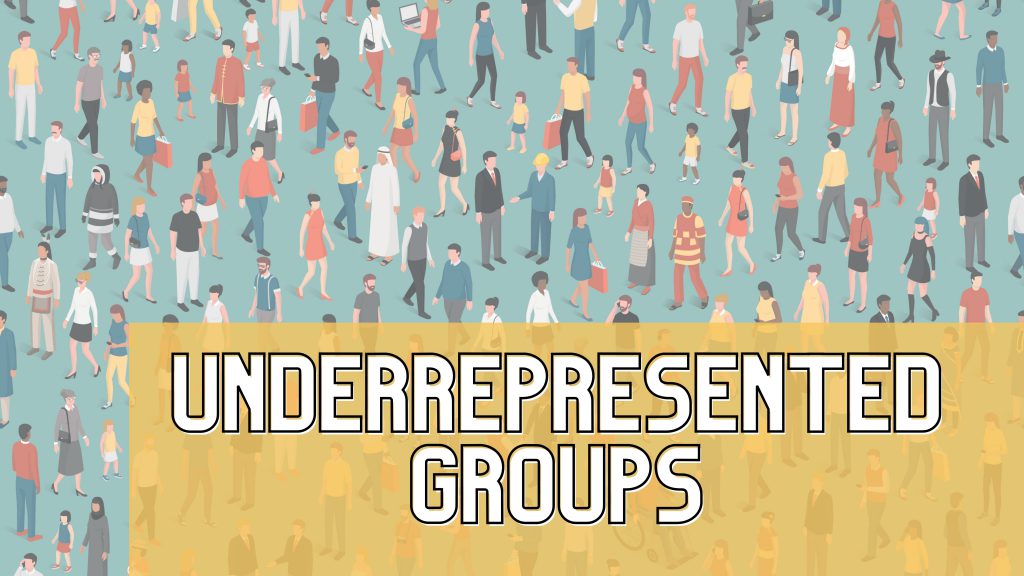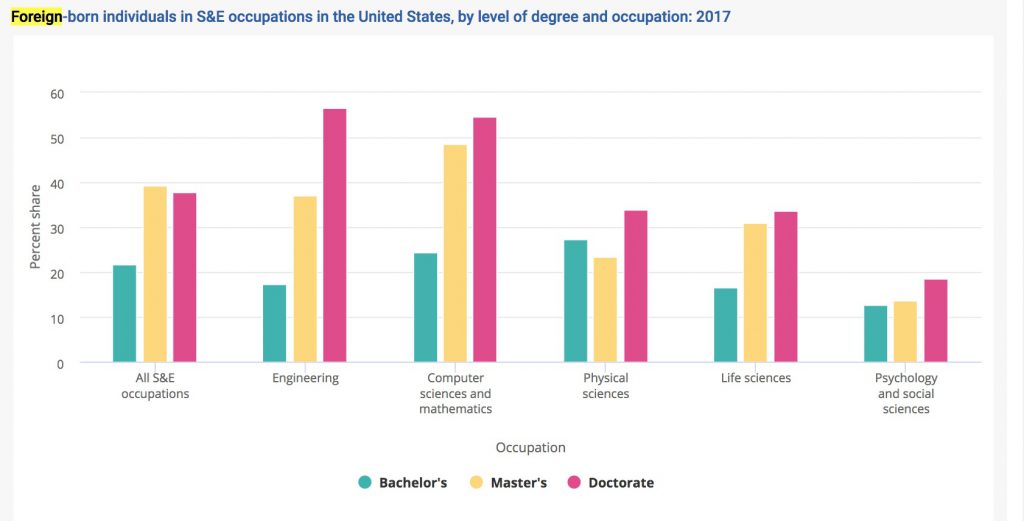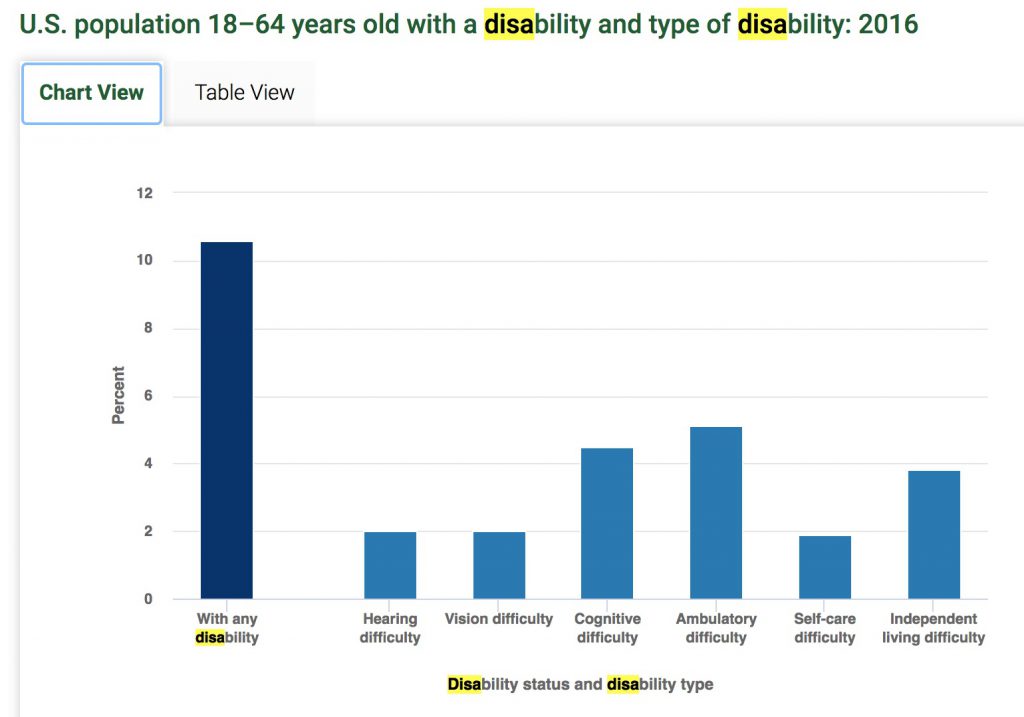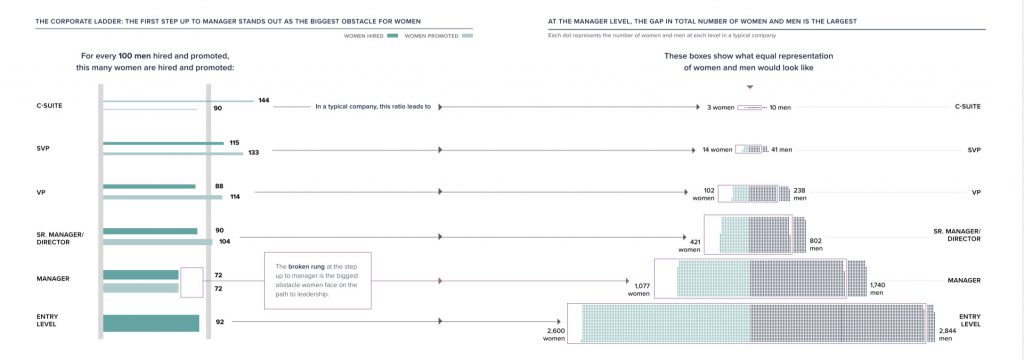- 20+ Helpful Recruitment Advertising Agencies (2026) - January 5, 2026
- 16 Helpful Career Site Self-Service Tools for You - December 18, 2025
- Last Week I Had a Viral LinkedIn Post — But Why? (And What TA Folks Can Learn From It) - December 8, 2025
Many companies are focusing on minority groups as a part of their diversity initiatives. In this article, we created a list of minority groups and included their % of the U.S. population [if we could find it] using census data. This article will use the term “underrepresented” and “minority” interchangeably. However, there is a trend away from the phrase “minority” because some people take offense to the “minor” part of “minority”. For this article we are using it more in the statistical sense.
What is a minority?
How do you define minority group? Minority groups describe racially, ethnically, or culturally distinct groups that are not in a larger majority group. Wikipedia says:
“In the United States, for example, non-Hispanic Whites constitute the majority (63.4%) and all other racial and ethnic groups (Mexican, African Americans, Asian Americans, American Indian, and Native Hawaiians) are classified as “minorities”.”
What is an underrepresented group?
What is an underrepresented group? An underrepresented group is a subset of a population with a smaller percentage than the general population—for example, people of color (POC) or indigenous people. Companies also use terms such as underrepresented ethnic groups, underrepresented communities, and underrepresented cultures to describe these groups.
Some consider minority vs underrepresented group to be the same. The only difference we found is that an underrepresented group is a subset of a minority group. (e.g. If the percentage of minority Black women in the U.S. is 12.3% and the percentage of Black women in a company is 5%, the Black women employees would be an underrepresented group).
List of Underrepresented Groups

Ethnic Minority Groups
Now let’s have a look at the examples of minority groups. If you want deeper definitions of some of these minority group terms, they are listed in The Diversity & Inclusion Glossary [a List of 200+ Terms].
Hispanic or Latino (18.5%)
Hispanics and Latinos is one of the biggest minority groups in America. Hispanic is a term used to describe people who speak Spanish and/or are descended from Spanish-speaking populations. Latino is a term used to describe people who are from or descended from people from Latin America.
The NY Times reported in 2019, that this underrepresented ethnic group:
“represented only three percent of lead or co-lead roles in top-performing movies during the last 12 years”
Traditionally, the Hispanic and Latino community is also one of the most underrepresented groups in business, especially in the science and engineering field.
According to Minority Rights Group International, the Hispanic/Latino population is on the rise. But so is the name of this underrepresented group.
“Each of these communities favours nationally specific names over any general term, but ‘Latino’ has emerged as the most popular alternative to ‘Hispanics’, which has long been favoured by government agencies and is used interchangeably with ‘Latinos’.”
Latinx is another term that has gained popularity. What is Latinx? Latinx is a gender-neutral term used to replace Latino or Latina when referring to a person of Latin-American descent.
Foreign-born Persons (13.5%)
The U.S. Census Bureau defines the underrepresented group, Foreign-born persons as:
“anyone who was not a U.S. citizen or a U.S. national at birth. This includes respondents who indicated they were a U.S. citizen by naturalization or not a U.S. citizen.”
This group represents 13.5% of the U.S. population. A positive for this underrepresented group is that foreign-born persons with higher-level degrees are starting to make up a larger percentage of the U.S. workforce, according to the National Science Foundation. The image below shows the distribution of foreign-born individuals in various career fields.

Black/African American (13.4%)
Black means to be related to people who have ethnic origins in Africa, or not of white European descent. Black is often used interchangeably with African American in the United States.
Black people and African Americans have been known as historically underrepresented groups and there has been some controversy on whether it is acceptable to say “Black People”, “People of Color (POC)”, or “African American”. The terms Black and African American can be used interchangeably, according to Keith Mayes, associate professor of African American and African studies at the University of Minnesota.
Another, more recent term being used to describe the Black/African American minority ethnic groups is BIPOC. What does BIPOC mean? The BIPOC acronym stands for Black, Indigenous, People of Color.
The Black Lives Matter movement has shined a spotlight on this underrepresented community causing many companies to change their diversity goals and recruiting strategies.
Asian (5.9%)
Asians make up 5.9% of the U.S. population and are often called Asian Americans. Asian-American is a term that means to have origins in Asia or the Indian subcontinent. Asian-American includes people who live in the United States and indicate their race as:
- Asian
- Indian
- Chinese
- Filipino
- Korean
- Japanese
- Vietnamese
- Other Asian
There is some controversy around Asians being underrepresented in the workforce. PNAS did a study on Why East Asians but not South Asians are underrepresented in leadership positions in the United States and found that:
“Asians appear disproportionately underrepresented in leadership positions across different industries in the United States. This phenomenon is known as the “bamboo ceiling,” as bamboo “has always played an important economic and cultural role across Asia,” with the world’s largest bamboo areas in South Asia and East Asia. In US law firms, 11% of associates are Asian, whereas only 3% of partners are Asian. Even in the tech industry, where Asians are the ethnic group most likely to be hired (over 30% of the workforce), they are the least likely to be promoted to senior leadership positions (less than 15% of executives)”
Chinese Minority Groups
Chinese minority groups make up the largest subsection of the Asian minority group in the U.S. A study from researchers at MIT, the University of Michigan, and Columb is Business School studied the bamboo ceiling mentioned above. Their findings:
“East Asians (e.g., Chinese, Japanese) are less likely than South Asians (e.g., Indians, Pakistanis) and whites to attain leadership roles in American organizations.”
The same study found the following related to Asian minority groups:
- Prejudice: While prejudice affects all minority groups, it does not explain the leadership attainment gap between East Asians and South Asians. In fact, the studies consistently found that South Asians face more prejudice than East Asians in the U.S. For example: in one of the studies, non-Asian Americans evaluating job candidates preferred to befriend East Asians (e.g. share an office; live nearby), but endorsed South Asians more for leadership positions.
- Motivation: East and South Asians both scored high in motivation to work hard and motivation to attain leadership positions, indicating that insufficient motivation is not the main cause of the Bamboo Ceiling.
- Assertiveness: Importantly, cultural differences in assertiveness consistently explained the leadership attainment gap between East and South Asians. Across different kinds of studies, East Asians scored lower in communication assertiveness (i.e., speaking up, constructively disagreeing, standing one’s ground in a conflict), and this difference statistically accounted for the leadership attainment gap.
2 or more races (2.8%)
Only 2.8% of people who participated in the 2019 census chose “2 or more races” when asked to select their race. Someone with two or more races is considered “mixed race”. Mixed Race means a person who has parents that belong to different types of minority groups, races, or ethnic groups. Biracial is another term for mixed race.
This underrepresented group, much like Foreign-born persons, may include other underrepresented communities that are listed in this blog. For example, someone who identifies with 2 or more races, can also identify as a woman of color, a veteran, a person with a disability, or other minority groups.
American Indian and Alaska Native (1.3%)
The American Indians and Alaska Natives are also underrepresented cultures. The Leadership Conference on Civil Human Rights recently reported that:
“American Indians and Alaska Natives (AIAN or Native peoples) have been undercounted for decades and roughly one quarter (26 percent) of Natives currently live in hard-to-count Census tracts.”
Being “hard to count” has a negative effect on underrepresented groups because they will have:
- unequal political representation
- unequal access to vital public and private resources
What is the difference between American Indian and Alaska native?
Native American is a broad term that refers to people of North and South America but is generally used to describe the indigenous people from the United States. Native American is often used interchangeably with American Indian, although many Native Americans find the word “Indian” offensive and prefer to identify themselves by their specific tribe. Some companies and sports teams are even changing their names or mascots, because of racial bias related to the word “Indian”.
Alaska Native is a term for the indigenous people of Alaska. Alaska Natives consist of over 200 federally recognized tribes who speak 20 different languages.
Arab and other Middle Eastern American (.5%)
Arab and other Middle Eastern Americans have long been underrepresented communities. These groups share common U.S. cultures, faiths, and languages so they do not always consider themselves as underrepresented. But, they have been targets of bias and discrimination for many years.
Minority Rights Group International says:
- Negative stereotypes of Middle Eastern characters and of Islam have been common in US film and television, and in radio and newspaper commentaries.
- Following the 11 September 2001 attacks on the US, Arab Americans across the country subjected to harassment and discrimination both in their communities and at the hands of state agencies including arbitrary detention, racial profiling and aggressive checks and detention for questioning in US airports and border crossings.
- The Equal Employment Opportunity Commission (EEOC) and state and local fair employment agencies also documented a significant increase in the number of charges alleging workplace discrimination based on religion and/or national origin in the wake of September 2001, many filed by individuals who are or are perceived to be Muslim, Arab, South Asian or Sikh. These charges most commonly alleged harassment and unfair discharge.
Companies like Intel are creating Employee Resource Groups (ERGs) to help tackle the bias against this underrepresented group and others. Intel has 30+ ERGs, including the Arab Intel Community. These groups are organized to “provide an environment where employees from diverse backgrounds are valued, respected, challenged, acknowledged, and rewarded so they can achieve their potential and fulfill their career aspirations.”
Native Hawaiian and other Pacific Islander (.2%)
Similar to American Indians and Alaska Natives, Native Hawaiians and other Pacific Islanders are highly underrepresented communities. The COVID-19 pandemic has shined a brighter light on this issue. These minority groups are not being accurately counted in the U.S. Census, so in turn, they are at risk for not receiving public funding and the resources they need.
Other statistics related to these historically underrepresented groups (from the University of Hawaiʻi at Mānoa) are:
- Almost 20% of Native Hawaiians and Pacific Islanders live in poverty (U.S. average living below poverty: 12%) over 16% lack health coverage.
- Pacific Islanders have a per capital income 27% below the national average.15% of Native Hawaiians and other Pacific Islanders hold at least a bachelor’s degree compared to 28% for the entire population; 5% hold a graduate or professional degree compared to 10% of the entire population.
- Pacific Islanders are half as likely to have a bachelor’s degree in comparison with 27% for the total population and 49% of the Asian American population.
- Only 29% of Pacific Islanders between the ages of 18 and 24 are enrolled in a college or university, which is comparable to African Americans.
Other Minority Groups
There are a few other types of minority groups (outside the examples of minority ethnic groups above) that are important to note. Employers are often trying to recruit these groups because they are underrepresented at their company.
Veterans (17.6%)
Veterans are an underrepresented group in the U.S. population and in the workplace. Forbes published an article in April 2020 about Dispelling Myths About Military Veterans In The Civilian Workforce. Just like other minority groups, there are some common misconceptions around hiring veterans. According to Forbes, they are:
- The Turnover Myth: Veterans have difficultly integrating into the civilian workforce and tend to leave their first employers at a rapid rate.
- The Mental Illness Myth: Many veterans are unable to contribute and succeed in the civilian workforce because they struggle with mental illness.
- The Culture Myth: Veterans are unable to shift their ways of working to be productive in the civilian workforce.
- The Experience Myth: The time veterans spent serving in the military really doesn’t equate to experience in the civilian world.
Unlock Higher Ed reports that:
“Historically, only a small percentage of veterans have gone on to study at any college or university, much less one of our elite institutions.”
Military.com gives companies strategies for adding Veterans to their diverse workforce in their article Five Things to Help Recruit Veterans to Your Business.
Persons with Disabilities — Age 65 and under (8.6%)
Persons with disabilities are considered to be an underrepresented community because they make up just 8.6% of the U.S. population. Disability is a term used to describe people who have a mental or physical impairment which has a long-term effect on their ability to carry out day-to-day activities.
A National Science Foundation study about minority groups found:
“Disabilities do not necessarily limit a person’s ability to participate in educational experiences or to be productive in an occupation. Persons with disabilities may or may not require special accommodation to enable them to succeed in school or at work.”
The same study includes the chart below, showing the various disability types and the percentage of the population who indicated they had a disability.

Neurodiversity is considered by some to be a cognitive disability or mental impairment. Neurodiversity is a relatively new term coined in 1998 by autistic, Australian sociologist Judy Singer in 1998. The neurodiversity definition began as a way to describe people on the Autistic spectrum. Neurodiversity has since broadened to include people with:
- Autism
- Dyslexia
- ADHD (Attention Deficit Hyperactivity Order)
- Dyscalculia
- DSD (Dyspraxia)
- Dysgraphia
- Tourette Syndrome
- and other neurological differences
Women as Minorities
Women may make up 50.8% of the U.S. population, but still are underrepresented in the workplace.
A study focused on women’s empowerment (called Women in the Workplace 2019) shows signs of improvement, but CNET reports:
“Women still haven’t reached parity in the corporate workplace”
This chart from the Women in the Workplace report shows the gap between women and men in entry-level positions up to C-Level (e.g. for every 10 C-Suite roles, there are only 3 women in the same role).

Other jobs that have low female representation (according to Insider.com) are:
- aerospace engineers (7.8%)
- airline pilots (5.2%)
- architects (25.5%)
- camera operators and editors (21.4%)
- clergy (17.6%)
- construction roles (9.9%)
- farmers (24.4%)
- financial analysts (39.9%)
- firefighters (3.5%)
- software developers (19%)
In 2018 in the state of California, the “Women on Boards (Senate Bill 826)” was signed into law to advance equitable gender representation on California corporate boards.
Women of Color
Women of color are an even more underrepresented group. A March 2020 report highlighted some glaring statistics related to women of color as an underrepresented community. The report showed that:
“In 2019, women of color represented 18% of entry-level positions. Few advanced to leadership positions: managers (12%), senior managers/directors (9%), VPs (7%), SVPs (5%), and C-suite positions 4%). In 2019, Black and Hispanic women made up a smaller percentage of total women employed in management, business, and financial operations occupations than white or Asian women.”
Also in the report, the percentage of women of color among US employees in 2019:
- Hispanic or Latinas: 10.3%
- Black women: 12.3 %
- Asian women: 18.3%
Hiring women of color and other underrepresented groups is a growing trend in top companies focused on DEI. So ideally these percentages will increase.
LGBTQ+
Is LGBTQ underrepresented?
Yes. The LGBTQ community is a historically underrepresented group. What is LGBT?
LGBT — Abbreviation for lesbian, gay, bisexual, and transgender (often used to encompass sexual preference and gender identities that do not correspond to heterosexual norms).
LGBT is an acronym with multiple variations such as:
LGBTQ — Lesbian, gay, bisexual, transgender, and queer (or questioning).
LGBTQIA — Lesbian, gay, bisexual, transgender, queer (or questioning), intersex, and asexual (or allies).
LGBTA — Lesbian, gay, bisexual, transgender, and asexual/aromantic/
agender. LGBTIQQ — Lesbian, Gay, Bisexual, Transgender, Intersex, Queer, and Questioning.
This minority group faces challenges in society and in the workplace. IMD’s article on Thrive as an LGBT+ executive or ally speaks to the experience of the LGBTQ community at work. The article says:
“Hostility in the workplace can be even stronger for minorities within minorities, who often suffer from “double discrimination,” e.g., LGBT+ individuals of color, as well as lesbian and transgender workers.”
There are even some countries where consensual same-sex activity is still criminalized.
Diversity Goals for Underrepresented Groups
Many companies are using some version of “underrepresented groups” in their diversity goals. The 5 companies below are no exception:
- Yelp has set a diversity goal to match the percentage of employees from underrepresented ethnicities with the user base in each area across the country. For example, if an area is 50% Latinx, the Yelp employees in that area should be 50% Latinx.
- Alphabet, Inc. parent company of Google, plans to increase the proportion of “leadership representation of underrepresented groups” overall by 30% at the company by 2025.
- Intel’s recent Corporate Responsibility Report says they plan to “increase the number of women in technical roles to 40% and double the numbers of women and underrepresented minorities in senior roles by 2030.”
- HP Inc. plans to double the number of Black and African-American individuals who are serving as executives by 2025 and continuing to increase the growing percentage of hiring from underrepresented communities — including women, minorities, veterans and persons with disabilities.
- VMWare’s Diversity Goal is “No hire unless an underrepresented group is interviewed”
- The West Coast Conference instituted the “Russell Rule,” which is an in-house made interview policy to promote people of color. The policy is named after NBA Hall of Famer and USF legend Bill Russell. Mercury News reported that: “The conference’s hiring initiative will require each of its member schools, including Saint Mary’s, Santa Clara, Pacific and USF in the Bay Area and beyond, to follow new guidelines when hiring any head coach, full-time assistant coach, athletic director or senior administrator in the athletic department. Specifically, the league announced Monday, the final candidates must include at least one person of “an underrepresented community.””
Why I wrote this?
Our mission here at Ongig is to transform your job descriptions to attract top-tier and diverse talent. Our Text Analyzer software analyzes every word of your job descriptions to ensure they are inclusive to everyone, especially underrepresented groups.
Shoutouts
- What is Underrepresented Groups (by IGI Global)
- United States Census Bureau’s Quick Facts on Population Characteristics
- African American or Black: Which term should you use? (by Adrienne Broaddus)
- Mikolaj Jan Pikorski and Ina Toegel’s article on Thrive as an LGBT+ executive or ally
- The Difference Between Hispanic And Latino (by Hispanic Network)
- The Leadership Conference on Civil and Human Rights report on American Indians and Alaska Natives In the 2020 Census
- Pandemic shows need for Native Hawaiians, Pacific Islanders participation in census (by Gabriella Abdul-Hakim and MaryAlice Parks)
- Catalyst.org’s report on Women of Color in the United States: Quick Take
- World Directory of Minorities and Indigenous Peoples (by Minority Rights Group International)
- Why East Asians but not South Asians are underrepresented in leadership positions in the United States
- Intel’s page on Employee Resource Groups
- Women in the Workplace (by McKinsey & Co/LeanIn.org)
- Recognizing and removing barriers to STEM careers for Native Hawaiians and Pacific Islanders (by the University of Hawaiʻi at Mānoa)
- Five Things to Help Recruit Veterans to Your Business (by Military.com)
- George Leef’s article on Aren’t Veterans an ‘Underrepresented’ Group that Would Add ‘Diversity’?
- Erin Carson’s blog on Women still haven’t reached parity in the corporate workplace
- Chris Cancialosi’s blog on CEO Spotlight: Dispelling Myths About Military Veterans In The Civilian Workforce
- Wikipedia’s definitions of Minority and Majority Groups
- 10 occupations that are still dominated by men (by Talia Lakritz)
- Researchers Answer a Diversity Puzzle: Why Chinese Americans but not Indian Americans are Underrepresented in Leadership Positions (by Columbia Business School)
- Women, Minorities, and Persons with Disabilities in Science and Engineering (by National Science Foundation)
